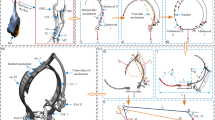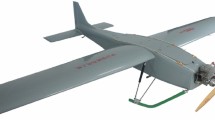Abstract
Close formation flight is one of the most complicated problems on multi-uninhabited aerial vehicles (UAVs) coordinated control. Based on the nonlinear model of multi-UAVs close formation, a novel type of control strategy of using hybrid receding horizon control (RHC) and differential evolution algorithm is proposed. The issue of multi-UAVs close formation is transformed into several on-line optimization problems at a series of receding horizons, while the differential evolution algorithm is adopted to optimize control sequences at each receding horizon. Then, based on the Markov chain model, the convergence of differential evolution is proved. The working process of RHC controller is presented in detail, and the stability of close formation controller is also analyzed. Finally, three simulation experiments are performed, and the simulation results show the feasibility and validity of our proposed control algorithm.
Similar content being viewed by others
References
Paul T, Krogstad T R, Gravdahl J T. Modeling of UAV formation flight using 3D potential field. Simul Mod Pract Th, 2008, 16: 1453–1462
Keviczky T, Fregene K, Borrelli F, et al. Coordinated autonomous vehicle formations: decentralization, control synthesis and optimization. In: Proceedings of the 2006 American Control Conference. Minneapolis, 2006. 2022–2027
Fan Q J, Yang Z, Fang T. Research status of coordinated formation flight control for multi-UAVs. Acta Aeronaut Astronaut Sin, 2009, 30: 683–691
Proud A W, Pachter M, D’Azzo J J. Close formation flight control. In: AIAA Guidance Navigation and Control Conference and Exhibit, Portland, Oregon, 1999. 1231–1246
Binetti P, Ariyur K B, Krstic M, et al. Formation flight optimization using extremum seeking feedback. J Guid Control Dynam, 2003, 26: 132–142
Dargan J L, Pachter M, D’Azzo J J. Automatic formation flight control. In: AIAA Guidance, Navigation and Control Conference, Hilton Head Island, South Carolina, 1992. 838–857
Buzogany L E, Pachter M, D’Azzo J J. Automated control of aircraft in formation flight. In: AIAA Guidance, Navigation and Control Conference, Monterey, California, 1993. 1349–1370
Pachter M, D’Azzo J J, Proud A W. Tight formation flight control. J Guid Control Dynam, 2001, 24: 246–254
Wang J Y, Wei R X. Close Formation configuration control of cooperative UAV. Flight Dynam, 2008, 26: 34–37
Zong L B, Xie F, Qin S Y. Intelligent optimizing control of formation flight for UAVs based on MAS. Acta Aeronaut Astronaut Sin, 2008, 29: 1326–1333
Singh S N, Pachter M. Adaptive feedback linearization nonlinear close formation control of UAVs. In: Proceedings of the American Control Conference. Chicago, 2000. 854–858
Li Y, Li B, Sun Z, et al. Fuzzy technique based close formation flight control. In: Proceedings of the 31st Annual Conference of IEEE Industrial Electronics Society, New York, 2005. 40–44
Li B, Liao X H, Sun Z, et al. Robust autopilot for close Formation flight of multi-UAVs. In: Proceedings of the 38th Southeastern Symposium on System Theory, Cookeville, 2006. 294–298
Keviczky T, Fregene K, Borrelli F, et al. Coordinated autonomous vehicle formations: Decentralization, control synthesis and optimization. In: Proceedings of the 2006 American Control Conference, Minneapolis, Minnesota, 2006. 2022–2027
Hu X B, Chen W H, Paolo E D. Multiairport capacity management: genetic algorithm with receding horizon. IEEE Trans Intel Syst, 2007, 8: 254–263
Bhattacharya R, Balas G J, Kaya A, et al. Nonlinear receding horizon control of F-16 aircraft. In: Proceedings of the American Control Conference, Arlington, 2001. 518–522
Mayne D Q, Rawlings J B, Rao C V, et al. Constrained model predictive control: stability and optimality. Automatica, 2000, 36: 789–814
Storn R, Price K. Differential evolution—a simple and efficient adaptive scheme for global optimization over continuous spaces. Technical Report, International Computer Science Institute, Berkeley, 1995
Blake W, Multhopp D. Design, performance and modeling considerations for close formation flight. In: AIAA Guidance, Navigation, and Control Conference, Reston, Virginia, 1998. 476–486
Ding B C. Predictive Control: Theory and Methods. Beijing: China Machine Press, 2008. 12–26
Zielinski K, Laur R. Stopping criteria for differential evolution in constrained single-objective optimization. In: Advances in Differential Evolution. Berlin/Heidelberg: Springer 2008, 143: 111–138
Zielinski K, Weitkemper P, Laur R, et al. Parameter study for differential evolution using a power allocation problem including interference cancellation. In: Proceedings of the IEEE Congress on Evolutionary Computation, Vancouver, BC, 2006. 6748–6755
Storn R, Price K. Differential evolution-a simple and efficient heuristic for global optimization over continuous spaces. J Global Optim, 1997, 11: 341–359
Zhang W X, Liang Y. Mathematical Foundation of Genetic Algorithms. 2nd ed. Xi’an: Xi’an Jiaotong University Press, 2003. 67–117
Yang J J, Liu M, Wu C. Genetic algorithm based nonlinear model predictive control method. Control Decision, 2003, 18: 141–144
Author information
Authors and Affiliations
Corresponding author
Rights and permissions
About this article
Cite this article
Zhang, X., Duan, H. & Yu, Y. Receding horizon control for multi-UAVs close formation control based on differential evolution. Sci. China Inf. Sci. 53, 223–235 (2010). https://doi.org/10.1007/s11432-010-0036-6
Received:
Accepted:
Published:
Issue Date:
DOI: https://doi.org/10.1007/s11432-010-0036-6




